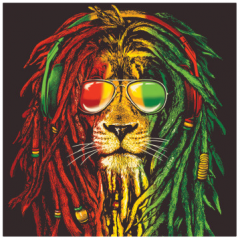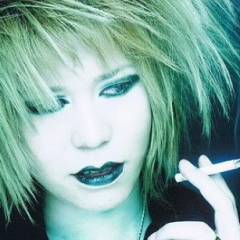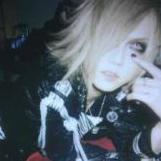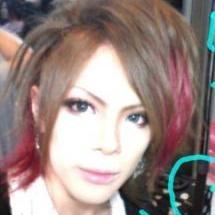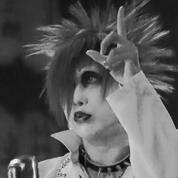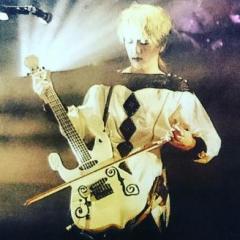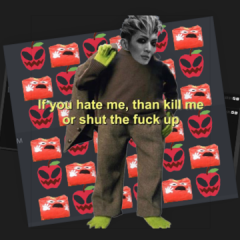-
Content Count
214 -
Joined
-
Last visited
-
Days Won
1
Reputation Activity
-
 Hakoniwa got a reaction from CAT5 in [Band Battle] Chanty vs. cinema staff
Hakoniwa got a reaction from CAT5 in [Band Battle] Chanty vs. cinema staff
cinema staff~!
I mean, they make music and also help making movies, HOW AWESOME CAN THEY BE?!
Seriously now, cinema staff all the way.
-
 Hakoniwa reacted to diryangrey in ...............hi
Hakoniwa reacted to diryangrey in ...............hi
hi, i'm ryan... i've been lurking here since forever, created an account a few months ago, and lately something's been telling me i should try to talk here more.
i'm not terribly good with forums though - something about the way anything i'd say gets kept on the site forever seems to trip me out a bit.
and i'm not sure how much of value i'd have to comment - so, i'll try to make myself useful and get to posting some (probably wildly inaccurate) translations~
as far as me....... got into vkei with ナイトメア about when their s/t came out, haven't found a band that resonates more with me since.
p sure i can find something to like in just about any style/scene, but i really think vkei hit its golden age between 1997-2007. at least to me.
as of typing this i'm also stanning diru, mucc, the gallo, and meji pretty hard. and since 2014 i've been living in varying degrees of Worried About Royz.
IRL i work at a sushi/udon place, it's p great, and i'm trying to get the hang of this whole 'understanding and speaking japanese' thing. it's hard tho.
Oh, and i'm trying to get a band together. also hard.
and that's basically it for me because i have no life outside visual kei.
Nice to meet all of you though - even if i haven't said much anything before i owe y'all a lot for recommending a lot of my fav bands.
special shoutout to all the staff/mods, rarezhut guys, and everyone who translates band shit bc it'd be so much harder to get into this dumb scene without people like you putting in all the work.
Oh and @ everyone feel free to hmu on twitter, username's same there as here
-

-

-
 Hakoniwa reacted to Ito in ギルガメッシュ (Girugamesh)
Hakoniwa reacted to Ito in ギルガメッシュ (Girugamesh)
First time in a while Ryo has put out something I haven't cared for (and I really dig the original)
-

-
 Hakoniwa reacted to Delkmiroph in Ryutaro (Plastic Tree) will release a solo abum
Hakoniwa reacted to Delkmiroph in Ryutaro (Plastic Tree) will release a solo abum
The last preview xD
-
 Hakoniwa reacted to Mamo in mouse on the keys new EP "Out of Body" release
Hakoniwa reacted to Mamo in mouse on the keys new EP "Out of Body" release
Ok lol I thought it was like your label or MH's label or something. lol
-
 Hakoniwa reacted to CAT5 in mouse on the keys new EP "Out of Body" release
Hakoniwa reacted to CAT5 in mouse on the keys new EP "Out of Body" release
mouse on the keys 『Out of Body』
DDCZ-2137 / ¥1,852+税
1. Intro
2. Earache
3. Dark Lights
4. Afterglow
5. Elegie
6. Out of Body
http://mouseonthekeys.net/?p=1195
https://twitter.com/mouseonthekeys
-

-
 Hakoniwa reacted to togz in The Japanese Language Learning / Support Thread!
Hakoniwa reacted to togz in The Japanese Language Learning / Support Thread!
I feel like I certainly need to study a bit more before jumping in to something like that.... but eventually that sounds like a cool idea.
-

-
 Hakoniwa got a reaction from togz in The Japanese Language Learning / Support Thread!
Hakoniwa got a reaction from togz in The Japanese Language Learning / Support Thread!
Would you guys be interested in practicing on HelloTalk with me? If so, I can share my username and we can practice too : D
Of course there'll be other people as well. But I can help with getting around the app and understanding how it works. It really helps a lot.
-

-
 Hakoniwa got a reaction from Komorebi in The Japanese Language Learning / Support Thread!
Hakoniwa got a reaction from Komorebi in The Japanese Language Learning / Support Thread!
@togz I used my mad mouse drawing skillz to explain, hope it makes sense :v
Also, please don't pay attention to the grammar now since this is casual japanese.
A: nani sore? (what's that?) -- far from speaker
B: kore wa GREEN THING desu! (this is a GREEN THING!) -- close to speaker
When (A) says "what's that?" they mean to ask what is the thing that is far from the speaker (A) but close to the listener (B).
A: ja, are wa? (then, what's that?) -- far from both
B: ah! are wa MONSTER desu! (ah! that is a MONSTER!) -- far from both
Then, (A) asks what's that thing that's far from both of them, so they can't use "sore" -- it's far from the listener (B) too. In this case, use "are". (B) does the same, for the same reason.
A: dore ga MONSTER desu ka? (which one is the MONSTER?)
B: migi desu. hidari wa KAWAII NEKO desu ne. (the one on the right. the one on the left is a CUTE CAT, right?)
There are two things there, so (A) asks "which one" of those is the monster. (A) uses "dore" as a way to say "which one", it's a way to express a question. Of course we already know the monster is the one on the right, since the one on the left is a very, very realistic cat.
The same relation can be found on other examples with kono, koko, etc.
Just to clarify:
* when talking about something
- KOno... (this...) -- close to the speaker. | Ex.: kono KAWAII NEKO ga suki desu (I like this CUTE CAT)
- SOno... (that...) -- far from speaker, close to listener | Ex.: sono MONSTER ga kirai desu (I hate that MONSTER)
- Ano... (that...) -- far from both speaker and listener | Ex.: ano GREEN THING wo tabetai! (I want to eat that GREEN THING)
- DOno... (which...) -- the distance doesn't matter, it's used to express a question regarding something they don't know about | Ex.: Dono ningen ga ichiban oishii no ka? (which human is tastier?)
KOko, SOko, Asoko and DOko are the same, but about place. Here, doko is using to ask "what place", i.e. "where".
There are some other variations too, but it's always the same.
Hope it didn't sound too confusing...
-
 Hakoniwa got a reaction from Peace Heavy mk II in The Japanese Language Learning / Support Thread!
Hakoniwa got a reaction from Peace Heavy mk II in The Japanese Language Learning / Support Thread!
@togz I used my mad mouse drawing skillz to explain, hope it makes sense :v
Also, please don't pay attention to the grammar now since this is casual japanese.
A: nani sore? (what's that?) -- far from speaker
B: kore wa GREEN THING desu! (this is a GREEN THING!) -- close to speaker
When (A) says "what's that?" they mean to ask what is the thing that is far from the speaker (A) but close to the listener (B).
A: ja, are wa? (then, what's that?) -- far from both
B: ah! are wa MONSTER desu! (ah! that is a MONSTER!) -- far from both
Then, (A) asks what's that thing that's far from both of them, so they can't use "sore" -- it's far from the listener (B) too. In this case, use "are". (B) does the same, for the same reason.
A: dore ga MONSTER desu ka? (which one is the MONSTER?)
B: migi desu. hidari wa KAWAII NEKO desu ne. (the one on the right. the one on the left is a CUTE CAT, right?)
There are two things there, so (A) asks "which one" of those is the monster. (A) uses "dore" as a way to say "which one", it's a way to express a question. Of course we already know the monster is the one on the right, since the one on the left is a very, very realistic cat.
The same relation can be found on other examples with kono, koko, etc.
Just to clarify:
* when talking about something
- KOno... (this...) -- close to the speaker. | Ex.: kono KAWAII NEKO ga suki desu (I like this CUTE CAT)
- SOno... (that...) -- far from speaker, close to listener | Ex.: sono MONSTER ga kirai desu (I hate that MONSTER)
- Ano... (that...) -- far from both speaker and listener | Ex.: ano GREEN THING wo tabetai! (I want to eat that GREEN THING)
- DOno... (which...) -- the distance doesn't matter, it's used to express a question regarding something they don't know about | Ex.: Dono ningen ga ichiban oishii no ka? (which human is tastier?)
KOko, SOko, Asoko and DOko are the same, but about place. Here, doko is using to ask "what place", i.e. "where".
There are some other variations too, but it's always the same.
Hope it didn't sound too confusing...
-
 Hakoniwa got a reaction from plastic_rainbow in The Japanese Language Learning / Support Thread!
Hakoniwa got a reaction from plastic_rainbow in The Japanese Language Learning / Support Thread!
@togz I used my mad mouse drawing skillz to explain, hope it makes sense :v
Also, please don't pay attention to the grammar now since this is casual japanese.
A: nani sore? (what's that?) -- far from speaker
B: kore wa GREEN THING desu! (this is a GREEN THING!) -- close to speaker
When (A) says "what's that?" they mean to ask what is the thing that is far from the speaker (A) but close to the listener (B).
A: ja, are wa? (then, what's that?) -- far from both
B: ah! are wa MONSTER desu! (ah! that is a MONSTER!) -- far from both
Then, (A) asks what's that thing that's far from both of them, so they can't use "sore" -- it's far from the listener (B) too. In this case, use "are". (B) does the same, for the same reason.
A: dore ga MONSTER desu ka? (which one is the MONSTER?)
B: migi desu. hidari wa KAWAII NEKO desu ne. (the one on the right. the one on the left is a CUTE CAT, right?)
There are two things there, so (A) asks "which one" of those is the monster. (A) uses "dore" as a way to say "which one", it's a way to express a question. Of course we already know the monster is the one on the right, since the one on the left is a very, very realistic cat.
The same relation can be found on other examples with kono, koko, etc.
Just to clarify:
* when talking about something
- KOno... (this...) -- close to the speaker. | Ex.: kono KAWAII NEKO ga suki desu (I like this CUTE CAT)
- SOno... (that...) -- far from speaker, close to listener | Ex.: sono MONSTER ga kirai desu (I hate that MONSTER)
- Ano... (that...) -- far from both speaker and listener | Ex.: ano GREEN THING wo tabetai! (I want to eat that GREEN THING)
- DOno... (which...) -- the distance doesn't matter, it's used to express a question regarding something they don't know about | Ex.: Dono ningen ga ichiban oishii no ka? (which human is tastier?)
KOko, SOko, Asoko and DOko are the same, but about place. Here, doko is using to ask "what place", i.e. "where".
There are some other variations too, but it's always the same.
Hope it didn't sound too confusing...
-
 Hakoniwa got a reaction from itsukoii in The Japanese Language Learning / Support Thread!
Hakoniwa got a reaction from itsukoii in The Japanese Language Learning / Support Thread!
@togz I used my mad mouse drawing skillz to explain, hope it makes sense :v
Also, please don't pay attention to the grammar now since this is casual japanese.
A: nani sore? (what's that?) -- far from speaker
B: kore wa GREEN THING desu! (this is a GREEN THING!) -- close to speaker
When (A) says "what's that?" they mean to ask what is the thing that is far from the speaker (A) but close to the listener (B).
A: ja, are wa? (then, what's that?) -- far from both
B: ah! are wa MONSTER desu! (ah! that is a MONSTER!) -- far from both
Then, (A) asks what's that thing that's far from both of them, so they can't use "sore" -- it's far from the listener (B) too. In this case, use "are". (B) does the same, for the same reason.
A: dore ga MONSTER desu ka? (which one is the MONSTER?)
B: migi desu. hidari wa KAWAII NEKO desu ne. (the one on the right. the one on the left is a CUTE CAT, right?)
There are two things there, so (A) asks "which one" of those is the monster. (A) uses "dore" as a way to say "which one", it's a way to express a question. Of course we already know the monster is the one on the right, since the one on the left is a very, very realistic cat.
The same relation can be found on other examples with kono, koko, etc.
Just to clarify:
* when talking about something
- KOno... (this...) -- close to the speaker. | Ex.: kono KAWAII NEKO ga suki desu (I like this CUTE CAT)
- SOno... (that...) -- far from speaker, close to listener | Ex.: sono MONSTER ga kirai desu (I hate that MONSTER)
- Ano... (that...) -- far from both speaker and listener | Ex.: ano GREEN THING wo tabetai! (I want to eat that GREEN THING)
- DOno... (which...) -- the distance doesn't matter, it's used to express a question regarding something they don't know about | Ex.: Dono ningen ga ichiban oishii no ka? (which human is tastier?)
KOko, SOko, Asoko and DOko are the same, but about place. Here, doko is using to ask "what place", i.e. "where".
There are some other variations too, but it's always the same.
Hope it didn't sound too confusing...
-
 Hakoniwa got a reaction from CAT5 in The Japanese Language Learning / Support Thread!
Hakoniwa got a reaction from CAT5 in The Japanese Language Learning / Support Thread!
@togz I used my mad mouse drawing skillz to explain, hope it makes sense :v
Also, please don't pay attention to the grammar now since this is casual japanese.
A: nani sore? (what's that?) -- far from speaker
B: kore wa GREEN THING desu! (this is a GREEN THING!) -- close to speaker
When (A) says "what's that?" they mean to ask what is the thing that is far from the speaker (A) but close to the listener (B).
A: ja, are wa? (then, what's that?) -- far from both
B: ah! are wa MONSTER desu! (ah! that is a MONSTER!) -- far from both
Then, (A) asks what's that thing that's far from both of them, so they can't use "sore" -- it's far from the listener (B) too. In this case, use "are". (B) does the same, for the same reason.
A: dore ga MONSTER desu ka? (which one is the MONSTER?)
B: migi desu. hidari wa KAWAII NEKO desu ne. (the one on the right. the one on the left is a CUTE CAT, right?)
There are two things there, so (A) asks "which one" of those is the monster. (A) uses "dore" as a way to say "which one", it's a way to express a question. Of course we already know the monster is the one on the right, since the one on the left is a very, very realistic cat.
The same relation can be found on other examples with kono, koko, etc.
Just to clarify:
* when talking about something
- KOno... (this...) -- close to the speaker. | Ex.: kono KAWAII NEKO ga suki desu (I like this CUTE CAT)
- SOno... (that...) -- far from speaker, close to listener | Ex.: sono MONSTER ga kirai desu (I hate that MONSTER)
- Ano... (that...) -- far from both speaker and listener | Ex.: ano GREEN THING wo tabetai! (I want to eat that GREEN THING)
- DOno... (which...) -- the distance doesn't matter, it's used to express a question regarding something they don't know about | Ex.: Dono ningen ga ichiban oishii no ka? (which human is tastier?)
KOko, SOko, Asoko and DOko are the same, but about place. Here, doko is using to ask "what place", i.e. "where".
There are some other variations too, but it's always the same.
Hope it didn't sound too confusing...
-
 Hakoniwa got a reaction from crossparallel in The Japanese Language Learning / Support Thread!
Hakoniwa got a reaction from crossparallel in The Japanese Language Learning / Support Thread!
I've been practicing a little in recent years, but I haven't been studying at all. Though practicing helps, I know I should study some too... >_>
As already mentioned above, I also use weblio & rikaichan/kun.
I started learning hiragana/katakana in high school (over 10 years ago) but I try to at least practice at times... I still don't know that many kanji though, mainly because I haven't been studying as I should. For character recognition (katakana, hiragana, kanji) and practicing, android's app Obenkyo works pretty well! I also try writing stuff from class in katakana/hiragana for practicing. But you see, if you're at this stage... PRACTICE A LOT. Like, write a lot, really, even if you have to spend 1 week on each row (a-i-u-e-o / ka-ki-ku-ke-ko / sa-shi-su-se-so / etc.). Practicing everyday, even if only five minutes, is very important. I started off with katakana and moved to hiragana when I finished it... but kept practicing it along with hiragana. Apps like Obenkyo help with memorizing and general recognition, but you have to write them in order to really learn them. Same with kanji.
For dictionaries, I use android's JED - Japanese-English Dictionary along with japanese-japanese dictionaries online and rikaichan. Plus google when looking for examples, of course. There's also this amazing website I found recently: http://chigai-allguide.com/
It helps you understand the nuances and differences between kanji that read the same way and seemily have the same meaning. It's also for japanese expressions. it's intended for japanese people, but having a somewhat good knowledge of the language helps you around it! You can look for specific words/expressions and find their definitions. Here's an example: http://chigai-allguide.com/怖いと恐いと強い/
Those two are read the same way, they have the same dictionary meaning and yet... they're not the same. This kind of thing helps learners a lot, since you can't easily find and understand it on your own.
Recently I've also been using an app to practice, it's called HelloTalk. It's not anything new, but the results were better than expected! It works like some kind of social media, one that you teach one (or more) language(s) and learn one (or more) languages in exchange. I'm teaching English and learning Japanese. You can see a timeline with posts from Japanese speakers who are learning English, be it in Japanese or English, and you can like, comment and... correct them. There's a special tool for that, and believe it or not, that very tool helps A LOT. There are also built-in translators, romanizators, you can even hear how things are supposed to be pronounced. You can also post your own stuff about your local culture and language, or anything you want, and interact with people... those interactions help you talk to people through the chat (they often initiate the conversation, but you can do it, too), that also allows corrections, readings, translations, romaji, etc., plus voice messages. I think even video messages are used, but I haven't done that. Anyway, it's pretty useful... it helps you practice everyday through conversation and you can actually ask for help without it feeling too awkward -- people are there for the same purpose as you afterall, that is learning & teaching. That's why you can also correct them, they are expecting to be corrected, as you also should. The key for using this is not being afraid to make mistakes and ask people to correct you when you're wrong, talking to them in japanese everyday is surprisingly effective... it makes thinking, understanding, reasoning and creating phrases in japanese a lot easier. Also be aware that japanese people will often compliment your Japanese even if it's not very good, it's just this cultural thing... apparently. Also they'll say "Wow, your japanese is so good!!" and think "(...for a foreigner)" lol.
I'm someone who has a hard time studying but prefers learning things through action, it makes things a little difficult at times. Still, studying makes it better, so it's good if you can do it too. If I remember something else, I'll post it here!
Anyway, let's practice together here too~~~! よろしく!m(_ _)m
-
 Hakoniwa got a reaction from Seimeisen in The Japanese Language Learning / Support Thread!
Hakoniwa got a reaction from Seimeisen in The Japanese Language Learning / Support Thread!
@togz I used my mad mouse drawing skillz to explain, hope it makes sense :v
Also, please don't pay attention to the grammar now since this is casual japanese.
A: nani sore? (what's that?) -- far from speaker
B: kore wa GREEN THING desu! (this is a GREEN THING!) -- close to speaker
When (A) says "what's that?" they mean to ask what is the thing that is far from the speaker (A) but close to the listener (B).
A: ja, are wa? (then, what's that?) -- far from both
B: ah! are wa MONSTER desu! (ah! that is a MONSTER!) -- far from both
Then, (A) asks what's that thing that's far from both of them, so they can't use "sore" -- it's far from the listener (B) too. In this case, use "are". (B) does the same, for the same reason.
A: dore ga MONSTER desu ka? (which one is the MONSTER?)
B: migi desu. hidari wa KAWAII NEKO desu ne. (the one on the right. the one on the left is a CUTE CAT, right?)
There are two things there, so (A) asks "which one" of those is the monster. (A) uses "dore" as a way to say "which one", it's a way to express a question. Of course we already know the monster is the one on the right, since the one on the left is a very, very realistic cat.
The same relation can be found on other examples with kono, koko, etc.
Just to clarify:
* when talking about something
- KOno... (this...) -- close to the speaker. | Ex.: kono KAWAII NEKO ga suki desu (I like this CUTE CAT)
- SOno... (that...) -- far from speaker, close to listener | Ex.: sono MONSTER ga kirai desu (I hate that MONSTER)
- Ano... (that...) -- far from both speaker and listener | Ex.: ano GREEN THING wo tabetai! (I want to eat that GREEN THING)
- DOno... (which...) -- the distance doesn't matter, it's used to express a question regarding something they don't know about | Ex.: Dono ningen ga ichiban oishii no ka? (which human is tastier?)
KOko, SOko, Asoko and DOko are the same, but about place. Here, doko is using to ask "what place", i.e. "where".
There are some other variations too, but it's always the same.
Hope it didn't sound too confusing...
-
 Hakoniwa reacted to nick in girugamesh ONEMAN TOUR 2016「鵺-period-」LIVE DVD BOX Special Limited Edition release
Hakoniwa reacted to nick in girugamesh ONEMAN TOUR 2016「鵺-period-」LIVE DVD BOX Special Limited Edition release
Ryo posted a picture of the special limited edition of Girugamesh last live DVD on Facebook.
-
 Hakoniwa reacted to nick in girugamesh ONEMAN TOUR 2016「鵺-period-」LIVE DVD BOX Special Limited Edition release
Hakoniwa reacted to nick in girugamesh ONEMAN TOUR 2016「鵺-period-」LIVE DVD BOX Special Limited Edition release
lol. There is a little typo on the booklet. 縁enishi became 緑(midori)
-
 Hakoniwa reacted to saishuu in Pokémon Sun & Moon
Hakoniwa reacted to saishuu in Pokémon Sun & Moon
So who's gonna play the upcoming Pokémon games?
Who's hyped?
Which version are you choosing?
What are your favorite Gen VII Pokémon so far and why is it Mimikyu?
12 DAYS TO GO!
Also feel free to give out your FCs ahead of the release.
-
 Hakoniwa reacted to itsukoii in The Japanese Language Learning / Support Thread!
Hakoniwa reacted to itsukoii in The Japanese Language Learning / Support Thread!
basically i think of the -re and -no as:
sore: "that is a [...]".
sono: "that [...] is/does this".
それはねこです。
That is a cat.
そのねこはかわいいです。
That cat is cute.
in sono sentences, it attaches to the noun, and a particle comes after them. the two words are one unit, whereas 'sore' is its own, and gets a particle right after.
i think i'm correct LMAO


